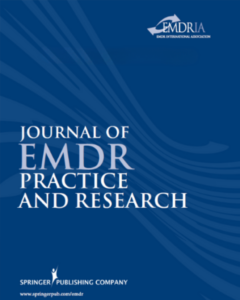Psychophysiological Changes During EMDR and Treatment Outcome (Journal of EMDR Practice and Research)
Study investigating whether psychophysiological changes during EMDR is related to subjective and objective reduction of PTSD symptoms.
Read MoreA Working Memory Explanation for the Effects of Eye Movements in EMDR (Journal of EMDR Practice and Research)
Study tested working memory theory to investigate the effects of eye movement (EM) on the components of autobiographical memory.
Read MoreCrucial Processes in EMDR: More Than Imaginal Exposure (Journal of EMDR Practice and Research)
The processes that underlie the effectiveness of EMDR are examined by evaluating the procedural differences between it and exposure therapy.
Read MoreInterhemispheric Interaction and Saccadic Horizontal Eye Movements: Implications for Episodic Memory, EMDR, and PTSD (Journal of EMDR Practice and Research)
The body of literature on the effects of bilateral saccadic eye movements, patterned after those employed in EMDR, on memory is reviewed.
Read MoreDialectical behavioral therapy and EMDR for adolescents in residential treatment: A practical and theoretical perspective (Residential Treatment for Children and Youth)
DBT and EMDR provide effective treatment for adolescents in group residential facilities, showing decreases in impact of traumatic memories.
Read MoreEye movement desensitization and reprocessing (EMDR) as a time-limited treatment intervention for body image disturbance and self-esteem: A single subject case study design (Journal of Psychotherapy in Independent Practice)
Clinical examination of EMDR to eating disorder symptoms such as body image disturbance and low self-esteem.
Read MoreEMDR in the treatment of addiction (Journal of Chemical Dependency Treatment)
EMDR offers so much promise and great challenges to addiction treatment providers. It is a powerful tool for trauma resolution.
Read MoreEye movement desensitization and reprocessing in the treatment of traumatized gay men (Journal of Gay & Lesbian Social Services)
Exploring the use of EMDR for gay men traumatized by hate crimes, sexual issues from traumatic experiences, and internalized homophobia
Read MoreAssessing the long-term effects of EMDR: Results from an 18-month follow up study with adult female survivors of CSA (Journal of Child Sexual Abuse)
Study provides evidence that the benefits of EMDR for adult female survivors of child sexual abuse can be maintained over an 18-month period.
Read MoreA randomized experimental test of the efficacy of EMDR treatment on negative body image in eating disorder inpatients (Eating Disorders: The Journal of Treatment & Prevention)
A randomized experimental trial comparing standard residential eating disorder treatment (SRT) to SRT plus EMDR therapy on negative body image.
Read MoreCessation of deliberate self harm following eye movement desensitisation and reprocessing: A case report (BMC Cases Journal)
A case report of using EMDR with an eighteen year old female patient presenting with acts of self cutting.
Read MoreEMDR Reprocessing of the Addiction Memory: Pretreatment, Posttreatment, and 1-Month Follow-Up (Journal of EMDR Practice and Research)
This randomized controlled study investigated the effects of EMDR therapy in the treatment of alcohol dependency.
Read More


